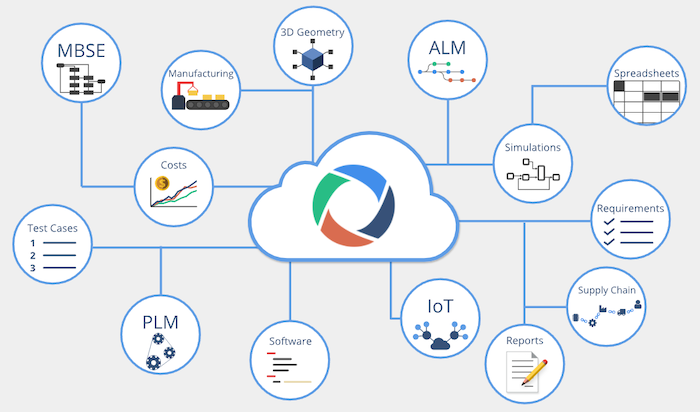Will IP management systems for electronic and semiconductor products reach out to modern open source software and open services?
April 29, 2020

Managing hardware and software intellectual property (IP) in large and even mid-size companies has become a full-time job. One must know what kind of in-house and third-party IP is available to a project, where the IP is located, what licenses apply, how best to rack and maintain the proper versions, and much more.
To get a better idea of the ongoing trends in IP management, Design News sat down to talk with Simon Butler, CEO and Founder of Methodics, an IP lifecycle management and traceability company. What follows is an edited version of that interview.
|
Image Source: CDNLive |
Design News: What trends do you see in IP lifecycle management especially in product design and manufacturing?
Simon Butler: Lots of designs are taking place in the automotive space. ISO 26262 remains a main focus for us, which means a higher level of traceability and functional safety awareness in the design process. Standards have a greater influence on IP functional safety than in the past. [Editor’s Note: Functional safety defines what is require to avoid unreasonable risk due to hazards caused by malfunctioning behavior of electrical and electronic automotive systems.]
Design News: The automotive ISO 26262 standard requires automated tools to be “fit-for-purpose,” i.e, the tools themselves must be good enough to do the job they were designed to do. In other words, many EDA tools that are used do design and verify automotive functional safety must also be ISO 26262 compliant. Is this a concern for IP management tools?
Simon Butler: Certainly, there are tools in some cases that need to be certified as being ISO 26262 compliant. We are looking into it for our tools but so far, our customers haven't required it. I’m not sure it’s really required for us as the IP management business is one of traceability and tracking the assets around the bill of materials rather than delivering the final actual design assets. So far, that hasn't been a requirement on us but it’s certainly something we're looking at.
Design News: In the past, IP management tools had to interface directly with very large database systems. Today, alternatives to databases based on Internet protocols – like the Open Services for Lifecycle Collaboration (OSLC) - enable a remote view of information without the use of large and often proprietary databases. OSLC are often implemented with web technologies such as RESTful service and related APIs. How do you see IP management tools adapting to such interfaces?
Simon Butler: You're right, there has traditionally been the use of a database-intensive PLM systems that can manage the entire product life cycle from requirements all the way through to manufacturing. But we’ve found in the design phase of the life cycle that there's a lot of interaction with different verification tools, physical design tools, simulators and the like. This is quite a diverse ecosystem around the different tools in use. One useful strategy is to link to this ecosystem of tools via API’s. Then, a single source of truth can be chosen by the customer knowing that the quality of the IP tool links is good.
|
Image Source: OSLC |
Design News: How does the move toward a digital twin for design through manufacturing effect the management of IP?
Simon Butler: IP management is a lifecycle process from requirements through the actual implementation of a product. To be successful, you need to track the often-enormous ecosystem of IP, both in-house and third-party IP, throughout the development lifecycle as well as across the company. You must have one place where you can find all the IP that is relevant for your new project, to track the project through its lifecycle and identify risks as you hand off from design to fabrication or manufacturing.
Design News: What is one unusual or interesting application that you’ve worked on that required the management of IP?
Simon Butler: Version control is becoming more and more interesting to people. We have some very large customers – especially in the embedded software space – that are focused on Git and that brings its own challenges. We’ve been able to address some of the challenges of using Git with our platform called Percipient, which helps enables each component of your design to be managed as an IP that is then tied to Git or another versioning tool. This is part of a wide trend to build out design flows to include requirements and simulation tools while doing it in a way that gives you a single dashboard for a version or an IP or tracking the Bill of Materials.
Editor’s Note: A few words about Git:
GIT, started in 2005, was created by Linus Torvald to aid in Linus kernel development. GIT is a free and open source distributed version control system that keeps track of every modification to the code. If any change or mistake is made, one can look back and compare with earlier version of code and find for any mistake. There are other source code management (SCM) tools like Subversion, CVS, Perforce, and ClearCase.
GitHub is one of the largest web-based GIT repository hosting services. It allows for code collaboration with anyone online. It adds extra functionality on top of git, such as UI, documentation, bug tracking, feature requests, pull requests and more.
|
Image Source: Adobe Stock |
RELATED ARTICLES:
John Blyler is a Design News senior editor, covering the electronics and advanced manufacturing spaces. With a BS in Engineering Physics and an MS in Electrical Engineering, he has years of hardware-software-network systems experience as an editor and engineer within the advanced manufacturing, IoT and semiconductor industries. John has co-authored books related to system engineering and electronics for IEEE, Wiley, and Elsevier.
About the Author(s)
You May Also Like








